Strategic Management and Leadership Skills Report: Nexus Ltd Analysis
VerifiedAdded on 2020/01/15
|10
|3077
|165
Report
AI Summary
This report delves into the critical relationship between strategic management and leadership skills, analyzing their impact on strategic decision-making within organizations. The report uses Nexus Ltd. as a case study, examining the interplay between these skills. It explores various leadership and management theories, such as trait and transformational theories, and their effects on organizational strategies. The analysis includes the evaluation of leadership styles, such as transformational and democratic leadership, and how these styles can be adapted to different situations. Furthermore, the report identifies appropriate methods for reviewing current leadership requirements and planning for future leadership skill development. The report also includes the development of a leadership strategy supporting organizational direction and concludes with a plan for leadership skill development for specific requirements and a report on the usefulness of the methods used.
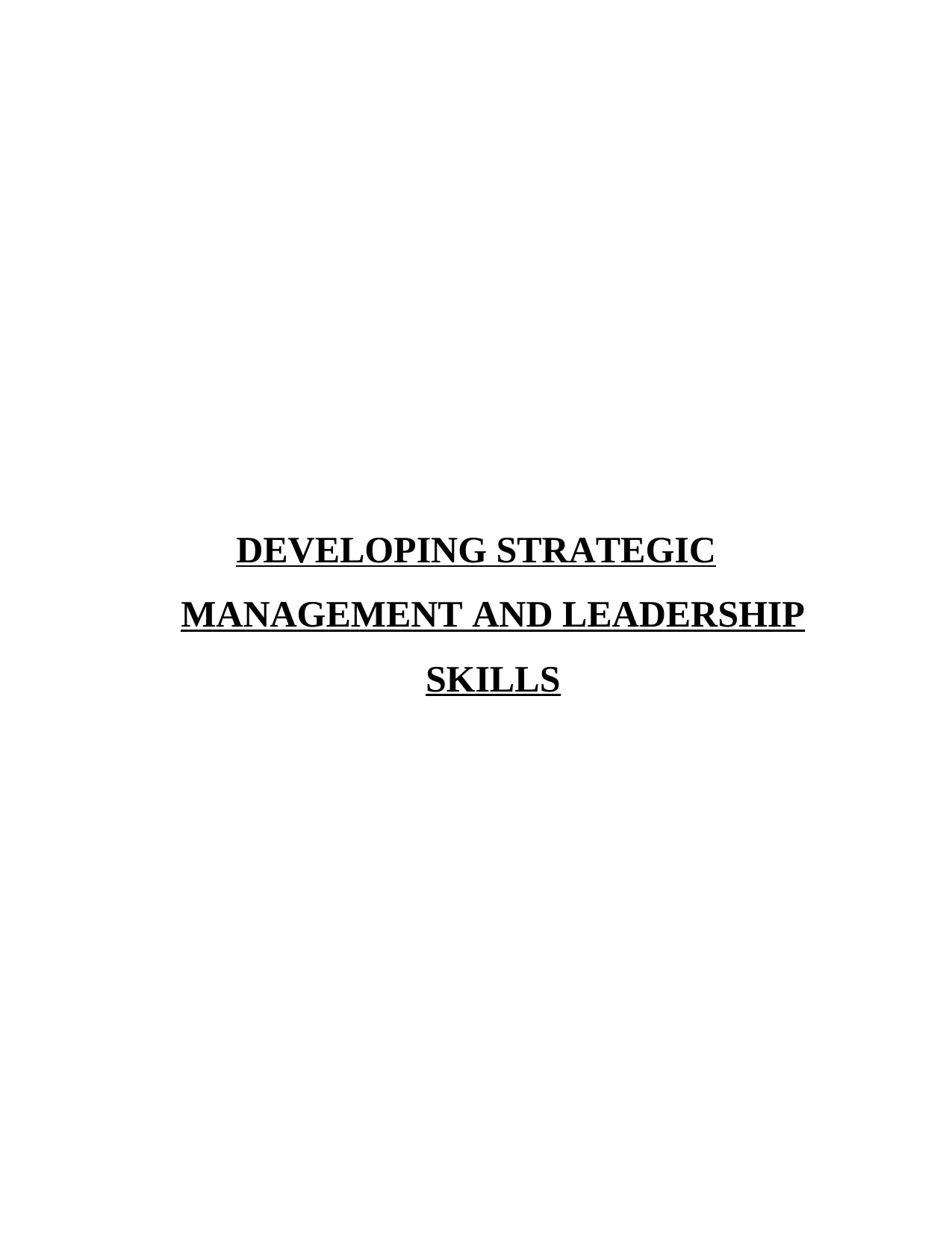
DEVELOPING STRATEGIC
MANAGEMENT AND LEADERSHIP
SKILLS
MANAGEMENT AND LEADERSHIP
SKILLS
Paraphrase This Document
Need a fresh take? Get an instant paraphrase of this document with our AI Paraphraser
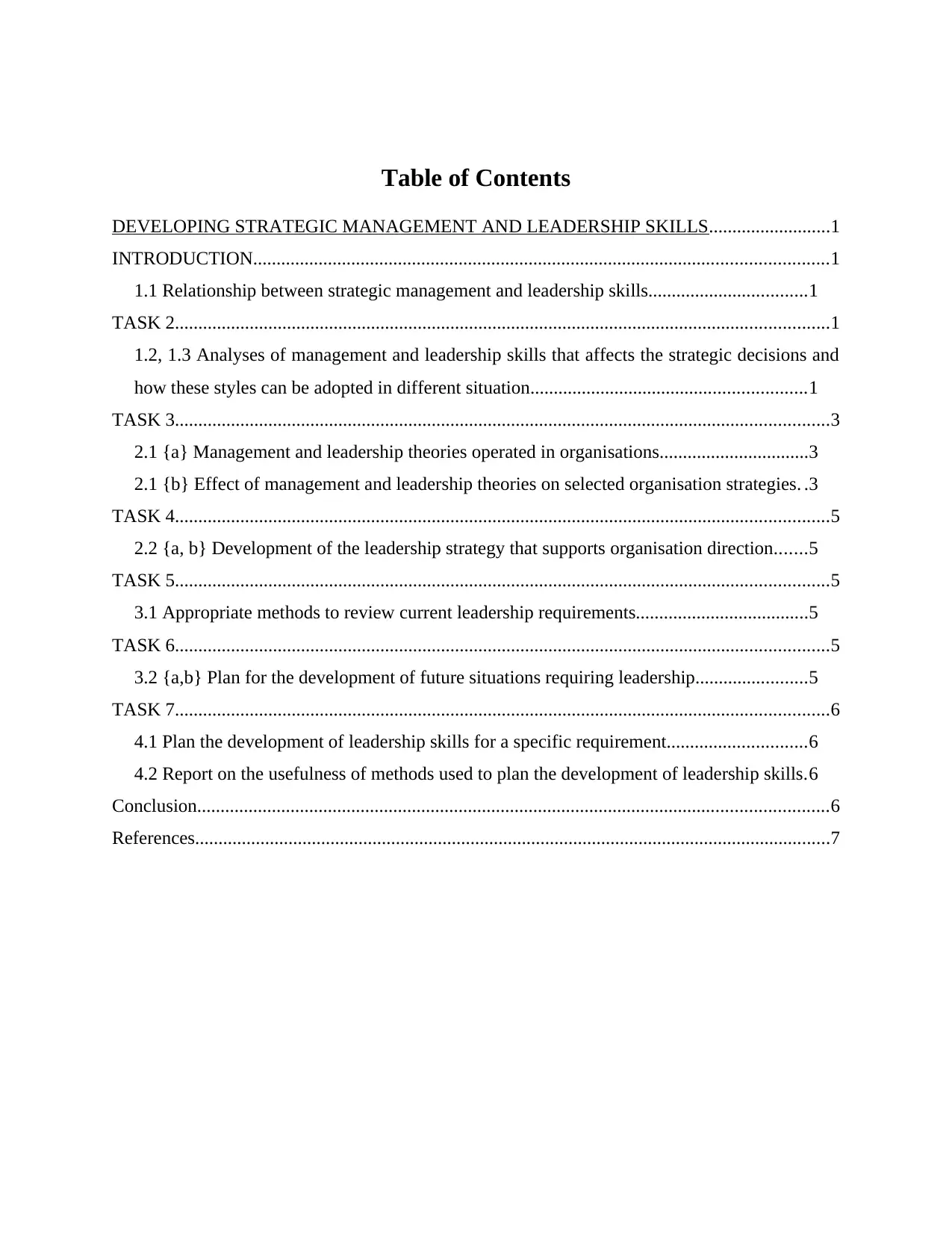
Table of Contents
DEVELOPING STRATEGIC MANAGEMENT AND LEADERSHIP SKILLS..........................1
INTRODUCTION...........................................................................................................................1
1.1 Relationship between strategic management and leadership skills..................................1
TASK 2............................................................................................................................................1
1.2, 1.3 Analyses of management and leadership skills that affects the strategic decisions and
how these styles can be adopted in different situation...........................................................1
TASK 3............................................................................................................................................3
2.1 {a} Management and leadership theories operated in organisations................................3
2.1 {b} Effect of management and leadership theories on selected organisation strategies. .3
TASK 4............................................................................................................................................5
2.2 {a, b} Development of the leadership strategy that supports organisation direction.......5
TASK 5............................................................................................................................................5
3.1 Appropriate methods to review current leadership requirements.....................................5
TASK 6............................................................................................................................................5
3.2 {a,b} Plan for the development of future situations requiring leadership........................5
TASK 7............................................................................................................................................6
4.1 Plan the development of leadership skills for a specific requirement..............................6
4.2 Report on the usefulness of methods used to plan the development of leadership skills.6
Conclusion.......................................................................................................................................6
References........................................................................................................................................7
DEVELOPING STRATEGIC MANAGEMENT AND LEADERSHIP SKILLS..........................1
INTRODUCTION...........................................................................................................................1
1.1 Relationship between strategic management and leadership skills..................................1
TASK 2............................................................................................................................................1
1.2, 1.3 Analyses of management and leadership skills that affects the strategic decisions and
how these styles can be adopted in different situation...........................................................1
TASK 3............................................................................................................................................3
2.1 {a} Management and leadership theories operated in organisations................................3
2.1 {b} Effect of management and leadership theories on selected organisation strategies. .3
TASK 4............................................................................................................................................5
2.2 {a, b} Development of the leadership strategy that supports organisation direction.......5
TASK 5............................................................................................................................................5
3.1 Appropriate methods to review current leadership requirements.....................................5
TASK 6............................................................................................................................................5
3.2 {a,b} Plan for the development of future situations requiring leadership........................5
TASK 7............................................................................................................................................6
4.1 Plan the development of leadership skills for a specific requirement..............................6
4.2 Report on the usefulness of methods used to plan the development of leadership skills.6
Conclusion.......................................................................................................................................6
References........................................................................................................................................7
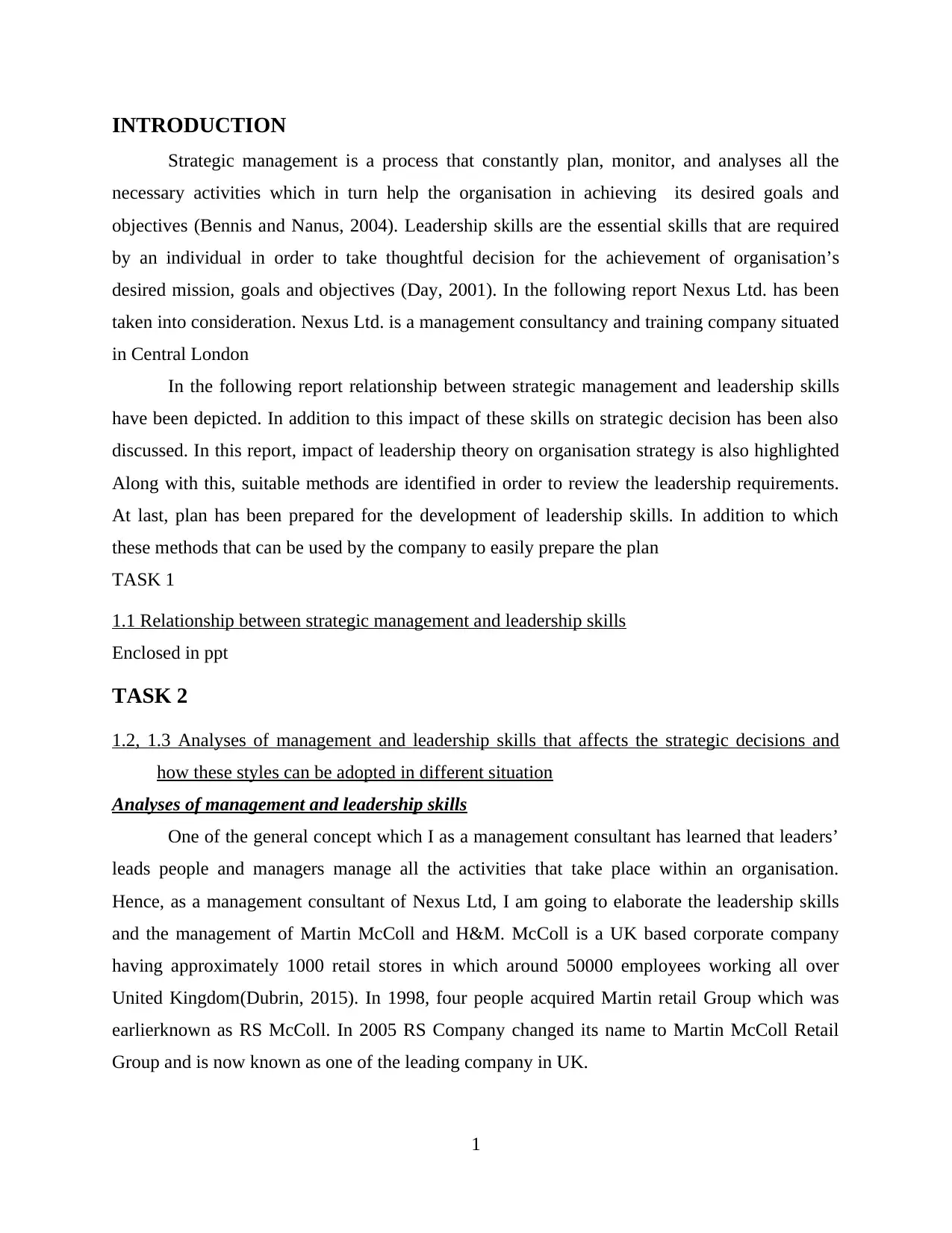
INTRODUCTION
Strategic management is a process that constantly plan, monitor, and analyses all the
necessary activities which in turn help the organisation in achieving its desired goals and
objectives (Bennis and Nanus, 2004). Leadership skills are the essential skills that are required
by an individual in order to take thoughtful decision for the achievement of organisation’s
desired mission, goals and objectives (Day, 2001). In the following report Nexus Ltd. has been
taken into consideration. Nexus Ltd. is a management consultancy and training company situated
in Central London
In the following report relationship between strategic management and leadership skills
have been depicted. In addition to this impact of these skills on strategic decision has been also
discussed. In this report, impact of leadership theory on organisation strategy is also highlighted
Along with this, suitable methods are identified in order to review the leadership requirements.
At last, plan has been prepared for the development of leadership skills. In addition to which
these methods that can be used by the company to easily prepare the plan
TASK 1
1.1 Relationship between strategic management and leadership skills
Enclosed in ppt
TASK 2
1.2, 1.3 Analyses of management and leadership skills that affects the strategic decisions and
how these styles can be adopted in different situation
Analyses of management and leadership skills
One of the general concept which I as a management consultant has learned that leaders’
leads people and managers manage all the activities that take place within an organisation.
Hence, as a management consultant of Nexus Ltd, I am going to elaborate the leadership skills
and the management of Martin McColl and H&M. McColl is a UK based corporate company
having approximately 1000 retail stores in which around 50000 employees working all over
United Kingdom(Dubrin, 2015). In 1998, four people acquired Martin retail Group which was
earlierknown as RS McColl. In 2005 RS Company changed its name to Martin McColl Retail
Group and is now known as one of the leading company in UK.
1
Strategic management is a process that constantly plan, monitor, and analyses all the
necessary activities which in turn help the organisation in achieving its desired goals and
objectives (Bennis and Nanus, 2004). Leadership skills are the essential skills that are required
by an individual in order to take thoughtful decision for the achievement of organisation’s
desired mission, goals and objectives (Day, 2001). In the following report Nexus Ltd. has been
taken into consideration. Nexus Ltd. is a management consultancy and training company situated
in Central London
In the following report relationship between strategic management and leadership skills
have been depicted. In addition to this impact of these skills on strategic decision has been also
discussed. In this report, impact of leadership theory on organisation strategy is also highlighted
Along with this, suitable methods are identified in order to review the leadership requirements.
At last, plan has been prepared for the development of leadership skills. In addition to which
these methods that can be used by the company to easily prepare the plan
TASK 1
1.1 Relationship between strategic management and leadership skills
Enclosed in ppt
TASK 2
1.2, 1.3 Analyses of management and leadership skills that affects the strategic decisions and
how these styles can be adopted in different situation
Analyses of management and leadership skills
One of the general concept which I as a management consultant has learned that leaders’
leads people and managers manage all the activities that take place within an organisation.
Hence, as a management consultant of Nexus Ltd, I am going to elaborate the leadership skills
and the management of Martin McColl and H&M. McColl is a UK based corporate company
having approximately 1000 retail stores in which around 50000 employees working all over
United Kingdom(Dubrin, 2015). In 1998, four people acquired Martin retail Group which was
earlierknown as RS McColl. In 2005 RS Company changed its name to Martin McColl Retail
Group and is now known as one of the leading company in UK.
1
⊘ This is a preview!⊘
Do you want full access?
Subscribe today to unlock all pages.

Trusted by 1+ million students worldwide
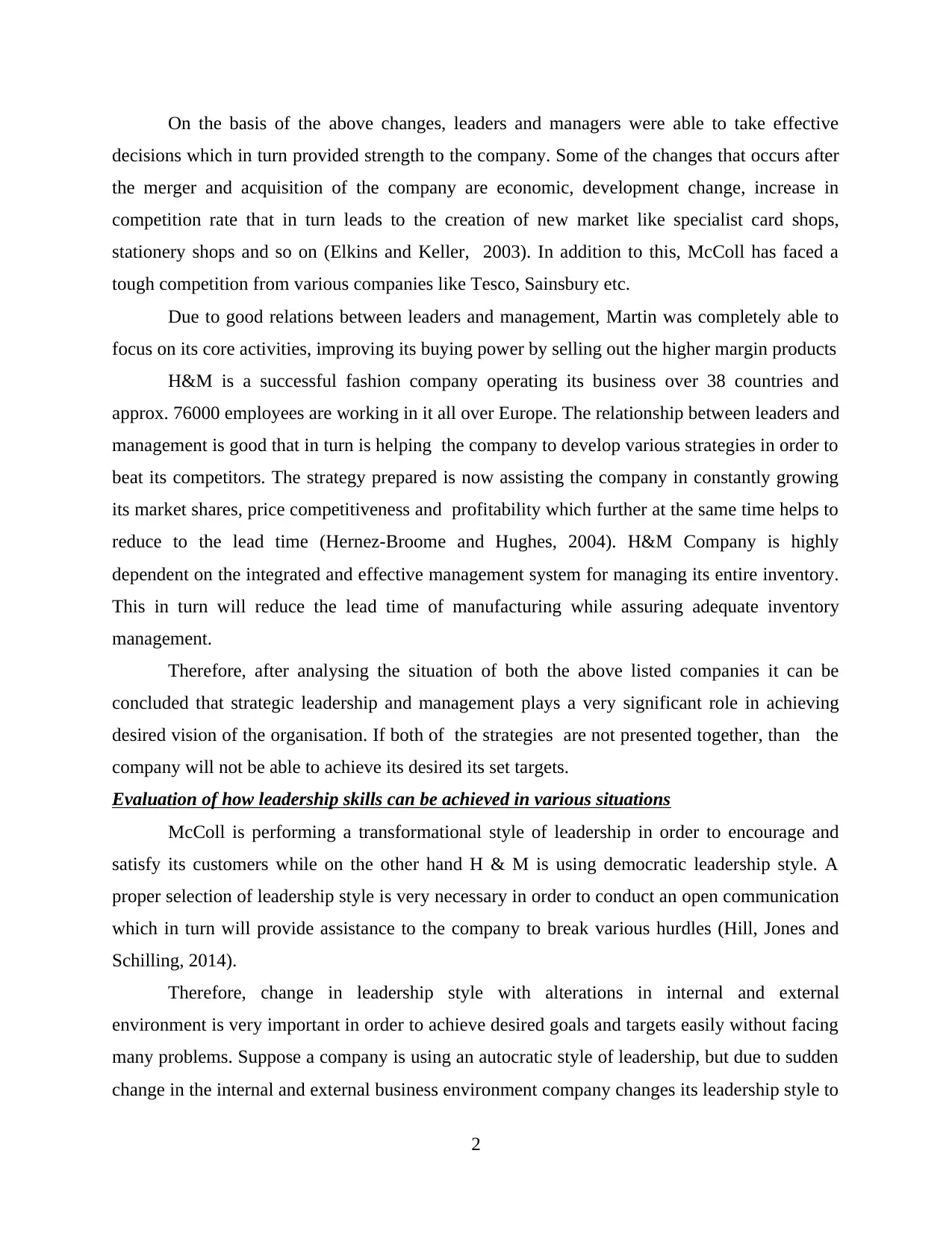
On the basis of the above changes, leaders and managers were able to take effective
decisions which in turn provided strength to the company. Some of the changes that occurs after
the merger and acquisition of the company are economic, development change, increase in
competition rate that in turn leads to the creation of new market like specialist card shops,
stationery shops and so on (Elkins and Keller, 2003). In addition to this, McColl has faced a
tough competition from various companies like Tesco, Sainsbury etc.
Due to good relations between leaders and management, Martin was completely able to
focus on its core activities, improving its buying power by selling out the higher margin products
H&M is a successful fashion company operating its business over 38 countries and
approx. 76000 employees are working in it all over Europe. The relationship between leaders and
management is good that in turn is helping the company to develop various strategies in order to
beat its competitors. The strategy prepared is now assisting the company in constantly growing
its market shares, price competitiveness and profitability which further at the same time helps to
reduce to the lead time (Hernez-Broome and Hughes, 2004). H&M Company is highly
dependent on the integrated and effective management system for managing its entire inventory.
This in turn will reduce the lead time of manufacturing while assuring adequate inventory
management.
Therefore, after analysing the situation of both the above listed companies it can be
concluded that strategic leadership and management plays a very significant role in achieving
desired vision of the organisation. If both of the strategies are not presented together, than the
company will not be able to achieve its desired its set targets.
Evaluation of how leadership skills can be achieved in various situations
McColl is performing a transformational style of leadership in order to encourage and
satisfy its customers while on the other hand H & M is using democratic leadership style. A
proper selection of leadership style is very necessary in order to conduct an open communication
which in turn will provide assistance to the company to break various hurdles (Hill, Jones and
Schilling, 2014).
Therefore, change in leadership style with alterations in internal and external
environment is very important in order to achieve desired goals and targets easily without facing
many problems. Suppose a company is using an autocratic style of leadership, but due to sudden
change in the internal and external business environment company changes its leadership style to
2
decisions which in turn provided strength to the company. Some of the changes that occurs after
the merger and acquisition of the company are economic, development change, increase in
competition rate that in turn leads to the creation of new market like specialist card shops,
stationery shops and so on (Elkins and Keller, 2003). In addition to this, McColl has faced a
tough competition from various companies like Tesco, Sainsbury etc.
Due to good relations between leaders and management, Martin was completely able to
focus on its core activities, improving its buying power by selling out the higher margin products
H&M is a successful fashion company operating its business over 38 countries and
approx. 76000 employees are working in it all over Europe. The relationship between leaders and
management is good that in turn is helping the company to develop various strategies in order to
beat its competitors. The strategy prepared is now assisting the company in constantly growing
its market shares, price competitiveness and profitability which further at the same time helps to
reduce to the lead time (Hernez-Broome and Hughes, 2004). H&M Company is highly
dependent on the integrated and effective management system for managing its entire inventory.
This in turn will reduce the lead time of manufacturing while assuring adequate inventory
management.
Therefore, after analysing the situation of both the above listed companies it can be
concluded that strategic leadership and management plays a very significant role in achieving
desired vision of the organisation. If both of the strategies are not presented together, than the
company will not be able to achieve its desired its set targets.
Evaluation of how leadership skills can be achieved in various situations
McColl is performing a transformational style of leadership in order to encourage and
satisfy its customers while on the other hand H & M is using democratic leadership style. A
proper selection of leadership style is very necessary in order to conduct an open communication
which in turn will provide assistance to the company to break various hurdles (Hill, Jones and
Schilling, 2014).
Therefore, change in leadership style with alterations in internal and external
environment is very important in order to achieve desired goals and targets easily without facing
many problems. Suppose a company is using an autocratic style of leadership, but due to sudden
change in the internal and external business environment company changes its leadership style to
2
Paraphrase This Document
Need a fresh take? Get an instant paraphrase of this document with our AI Paraphraser
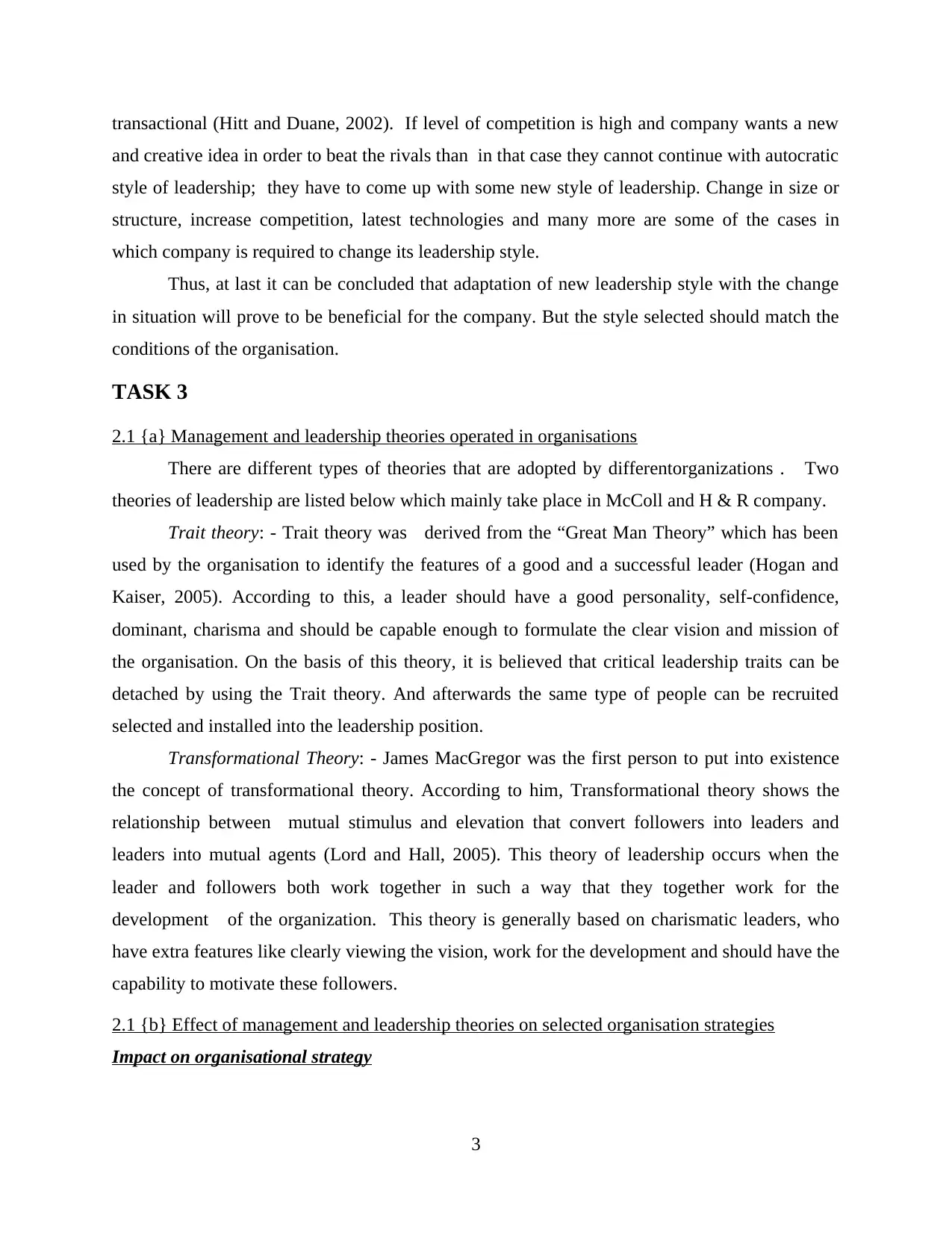
transactional (Hitt and Duane, 2002). If level of competition is high and company wants a new
and creative idea in order to beat the rivals than in that case they cannot continue with autocratic
style of leadership; they have to come up with some new style of leadership. Change in size or
structure, increase competition, latest technologies and many more are some of the cases in
which company is required to change its leadership style.
Thus, at last it can be concluded that adaptation of new leadership style with the change
in situation will prove to be beneficial for the company. But the style selected should match the
conditions of the organisation.
TASK 3
2.1 {a} Management and leadership theories operated in organisations
There are different types of theories that are adopted by differentorganizations . Two
theories of leadership are listed below which mainly take place in McColl and H & R company.
Trait theory: - Trait theory was derived from the “Great Man Theory” which has been
used by the organisation to identify the features of a good and a successful leader (Hogan and
Kaiser, 2005). According to this, a leader should have a good personality, self-confidence,
dominant, charisma and should be capable enough to formulate the clear vision and mission of
the organisation. On the basis of this theory, it is believed that critical leadership traits can be
detached by using the Trait theory. And afterwards the same type of people can be recruited
selected and installed into the leadership position.
Transformational Theory: - James MacGregor was the first person to put into existence
the concept of transformational theory. According to him, Transformational theory shows the
relationship between mutual stimulus and elevation that convert followers into leaders and
leaders into mutual agents (Lord and Hall, 2005). This theory of leadership occurs when the
leader and followers both work together in such a way that they together work for the
development of the organization. This theory is generally based on charismatic leaders, who
have extra features like clearly viewing the vision, work for the development and should have the
capability to motivate these followers.
2.1 {b} Effect of management and leadership theories on selected organisation strategies
Impact on organisational strategy
3
and creative idea in order to beat the rivals than in that case they cannot continue with autocratic
style of leadership; they have to come up with some new style of leadership. Change in size or
structure, increase competition, latest technologies and many more are some of the cases in
which company is required to change its leadership style.
Thus, at last it can be concluded that adaptation of new leadership style with the change
in situation will prove to be beneficial for the company. But the style selected should match the
conditions of the organisation.
TASK 3
2.1 {a} Management and leadership theories operated in organisations
There are different types of theories that are adopted by differentorganizations . Two
theories of leadership are listed below which mainly take place in McColl and H & R company.
Trait theory: - Trait theory was derived from the “Great Man Theory” which has been
used by the organisation to identify the features of a good and a successful leader (Hogan and
Kaiser, 2005). According to this, a leader should have a good personality, self-confidence,
dominant, charisma and should be capable enough to formulate the clear vision and mission of
the organisation. On the basis of this theory, it is believed that critical leadership traits can be
detached by using the Trait theory. And afterwards the same type of people can be recruited
selected and installed into the leadership position.
Transformational Theory: - James MacGregor was the first person to put into existence
the concept of transformational theory. According to him, Transformational theory shows the
relationship between mutual stimulus and elevation that convert followers into leaders and
leaders into mutual agents (Lord and Hall, 2005). This theory of leadership occurs when the
leader and followers both work together in such a way that they together work for the
development of the organization. This theory is generally based on charismatic leaders, who
have extra features like clearly viewing the vision, work for the development and should have the
capability to motivate these followers.
2.1 {b} Effect of management and leadership theories on selected organisation strategies
Impact on organisational strategy
3
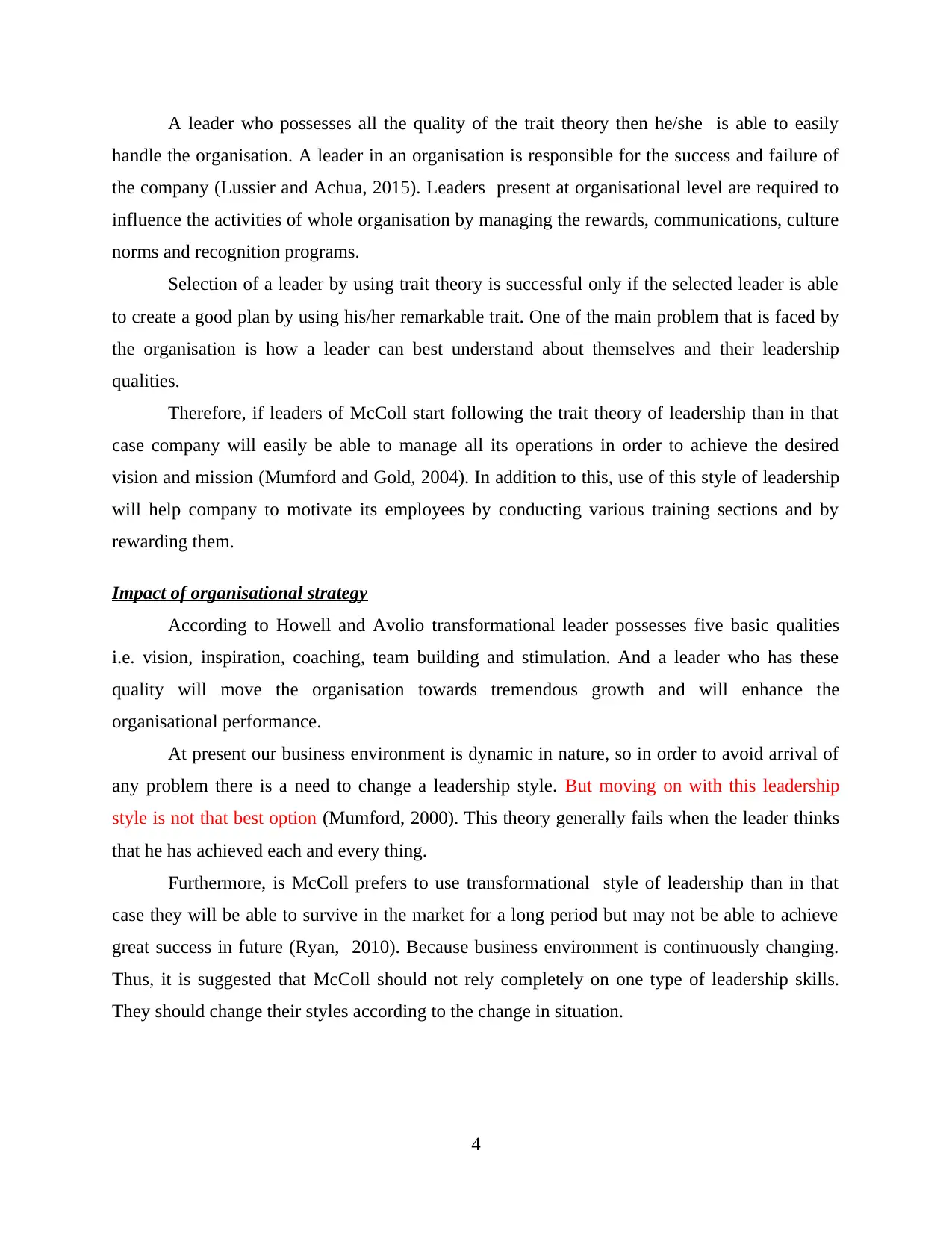
A leader who possesses all the quality of the trait theory then he/she is able to easily
handle the organisation. A leader in an organisation is responsible for the success and failure of
the company (Lussier and Achua, 2015). Leaders present at organisational level are required to
influence the activities of whole organisation by managing the rewards, communications, culture
norms and recognition programs.
Selection of a leader by using trait theory is successful only if the selected leader is able
to create a good plan by using his/her remarkable trait. One of the main problem that is faced by
the organisation is how a leader can best understand about themselves and their leadership
qualities.
Therefore, if leaders of McColl start following the trait theory of leadership than in that
case company will easily be able to manage all its operations in order to achieve the desired
vision and mission (Mumford and Gold, 2004). In addition to this, use of this style of leadership
will help company to motivate its employees by conducting various training sections and by
rewarding them.
Impact of organisational strategy
According to Howell and Avolio transformational leader possesses five basic qualities
i.e. vision, inspiration, coaching, team building and stimulation. And a leader who has these
quality will move the organisation towards tremendous growth and will enhance the
organisational performance.
At present our business environment is dynamic in nature, so in order to avoid arrival of
any problem there is a need to change a leadership style. But moving on with this leadership
style is not that best option (Mumford, 2000). This theory generally fails when the leader thinks
that he has achieved each and every thing.
Furthermore, is McColl prefers to use transformational style of leadership than in that
case they will be able to survive in the market for a long period but may not be able to achieve
great success in future (Ryan, 2010). Because business environment is continuously changing.
Thus, it is suggested that McColl should not rely completely on one type of leadership skills.
They should change their styles according to the change in situation.
4
handle the organisation. A leader in an organisation is responsible for the success and failure of
the company (Lussier and Achua, 2015). Leaders present at organisational level are required to
influence the activities of whole organisation by managing the rewards, communications, culture
norms and recognition programs.
Selection of a leader by using trait theory is successful only if the selected leader is able
to create a good plan by using his/her remarkable trait. One of the main problem that is faced by
the organisation is how a leader can best understand about themselves and their leadership
qualities.
Therefore, if leaders of McColl start following the trait theory of leadership than in that
case company will easily be able to manage all its operations in order to achieve the desired
vision and mission (Mumford and Gold, 2004). In addition to this, use of this style of leadership
will help company to motivate its employees by conducting various training sections and by
rewarding them.
Impact of organisational strategy
According to Howell and Avolio transformational leader possesses five basic qualities
i.e. vision, inspiration, coaching, team building and stimulation. And a leader who has these
quality will move the organisation towards tremendous growth and will enhance the
organisational performance.
At present our business environment is dynamic in nature, so in order to avoid arrival of
any problem there is a need to change a leadership style. But moving on with this leadership
style is not that best option (Mumford, 2000). This theory generally fails when the leader thinks
that he has achieved each and every thing.
Furthermore, is McColl prefers to use transformational style of leadership than in that
case they will be able to survive in the market for a long period but may not be able to achieve
great success in future (Ryan, 2010). Because business environment is continuously changing.
Thus, it is suggested that McColl should not rely completely on one type of leadership skills.
They should change their styles according to the change in situation.
4
⊘ This is a preview!⊘
Do you want full access?
Subscribe today to unlock all pages.

Trusted by 1+ million students worldwide
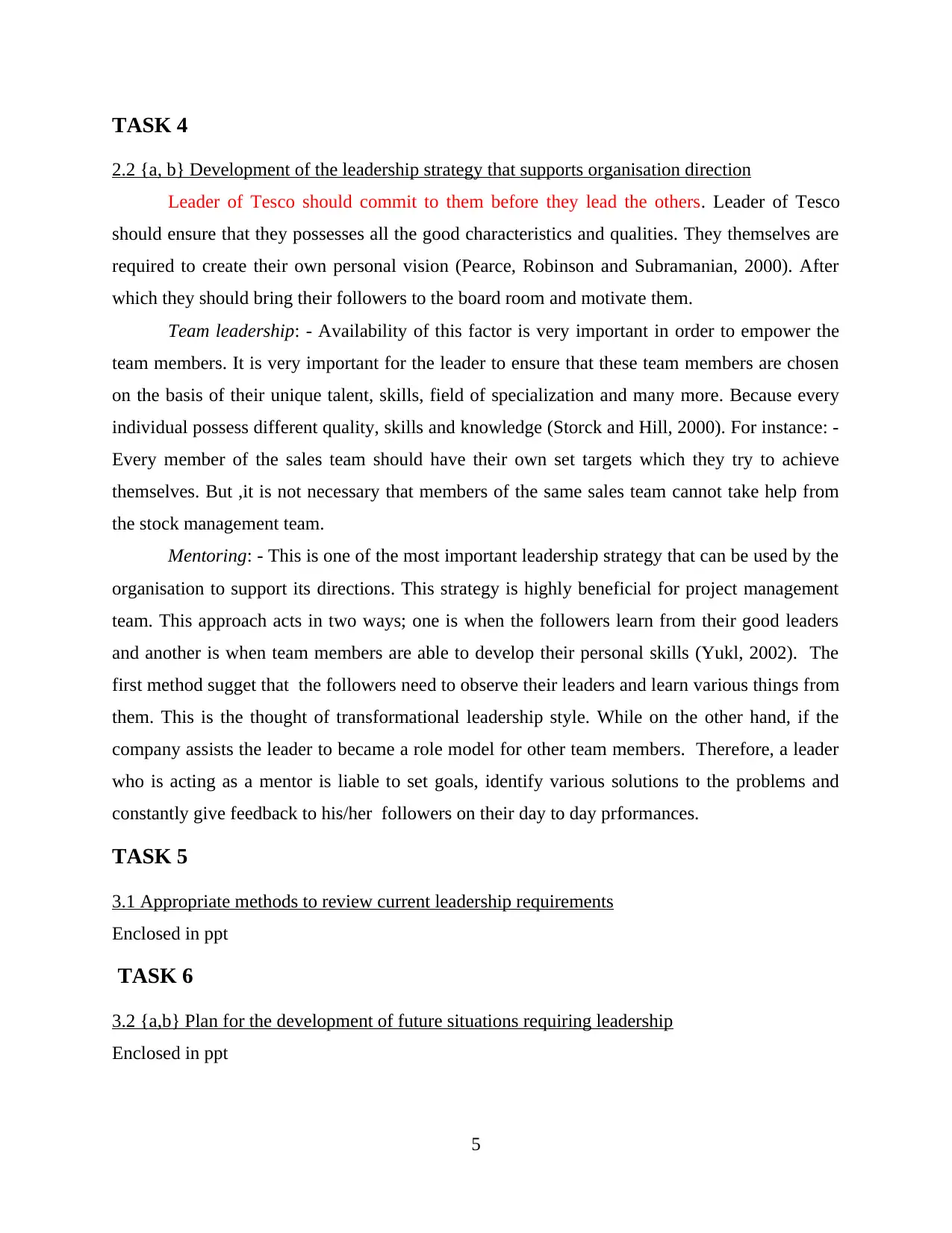
TASK 4
2.2 {a, b} Development of the leadership strategy that supports organisation direction
Leader of Tesco should commit to them before they lead the others. Leader of Tesco
should ensure that they possesses all the good characteristics and qualities. They themselves are
required to create their own personal vision (Pearce, Robinson and Subramanian, 2000). After
which they should bring their followers to the board room and motivate them.
Team leadership: - Availability of this factor is very important in order to empower the
team members. It is very important for the leader to ensure that these team members are chosen
on the basis of their unique talent, skills, field of specialization and many more. Because every
individual possess different quality, skills and knowledge (Storck and Hill, 2000). For instance: -
Every member of the sales team should have their own set targets which they try to achieve
themselves. But ,it is not necessary that members of the same sales team cannot take help from
the stock management team.
Mentoring: - This is one of the most important leadership strategy that can be used by the
organisation to support its directions. This strategy is highly beneficial for project management
team. This approach acts in two ways; one is when the followers learn from their good leaders
and another is when team members are able to develop their personal skills (Yukl, 2002). The
first method sugget that the followers need to observe their leaders and learn various things from
them. This is the thought of transformational leadership style. While on the other hand, if the
company assists the leader to became a role model for other team members. Therefore, a leader
who is acting as a mentor is liable to set goals, identify various solutions to the problems and
constantly give feedback to his/her followers on their day to day prformances.
TASK 5
3.1 Appropriate methods to review current leadership requirements
Enclosed in ppt
TASK 6
3.2 {a,b} Plan for the development of future situations requiring leadership
Enclosed in ppt
5
2.2 {a, b} Development of the leadership strategy that supports organisation direction
Leader of Tesco should commit to them before they lead the others. Leader of Tesco
should ensure that they possesses all the good characteristics and qualities. They themselves are
required to create their own personal vision (Pearce, Robinson and Subramanian, 2000). After
which they should bring their followers to the board room and motivate them.
Team leadership: - Availability of this factor is very important in order to empower the
team members. It is very important for the leader to ensure that these team members are chosen
on the basis of their unique talent, skills, field of specialization and many more. Because every
individual possess different quality, skills and knowledge (Storck and Hill, 2000). For instance: -
Every member of the sales team should have their own set targets which they try to achieve
themselves. But ,it is not necessary that members of the same sales team cannot take help from
the stock management team.
Mentoring: - This is one of the most important leadership strategy that can be used by the
organisation to support its directions. This strategy is highly beneficial for project management
team. This approach acts in two ways; one is when the followers learn from their good leaders
and another is when team members are able to develop their personal skills (Yukl, 2002). The
first method sugget that the followers need to observe their leaders and learn various things from
them. This is the thought of transformational leadership style. While on the other hand, if the
company assists the leader to became a role model for other team members. Therefore, a leader
who is acting as a mentor is liable to set goals, identify various solutions to the problems and
constantly give feedback to his/her followers on their day to day prformances.
TASK 5
3.1 Appropriate methods to review current leadership requirements
Enclosed in ppt
TASK 6
3.2 {a,b} Plan for the development of future situations requiring leadership
Enclosed in ppt
5
Paraphrase This Document
Need a fresh take? Get an instant paraphrase of this document with our AI Paraphraser
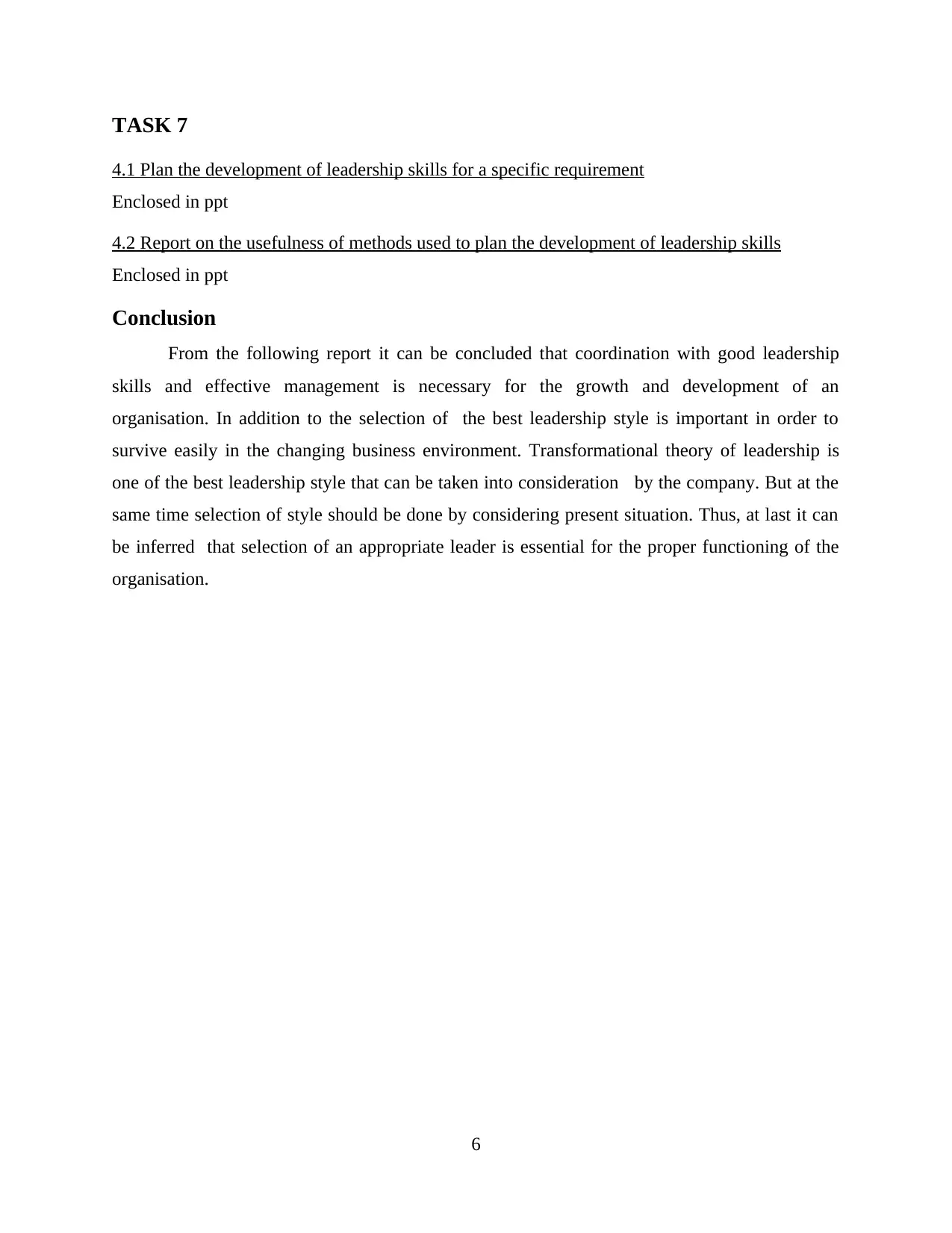
TASK 7
4.1 Plan the development of leadership skills for a specific requirement
Enclosed in ppt
4.2 Report on the usefulness of methods used to plan the development of leadership skills
Enclosed in ppt
Conclusion
From the following report it can be concluded that coordination with good leadership
skills and effective management is necessary for the growth and development of an
organisation. In addition to the selection of the best leadership style is important in order to
survive easily in the changing business environment. Transformational theory of leadership is
one of the best leadership style that can be taken into consideration by the company. But at the
same time selection of style should be done by considering present situation. Thus, at last it can
be inferred that selection of an appropriate leader is essential for the proper functioning of the
organisation.
6
4.1 Plan the development of leadership skills for a specific requirement
Enclosed in ppt
4.2 Report on the usefulness of methods used to plan the development of leadership skills
Enclosed in ppt
Conclusion
From the following report it can be concluded that coordination with good leadership
skills and effective management is necessary for the growth and development of an
organisation. In addition to the selection of the best leadership style is important in order to
survive easily in the changing business environment. Transformational theory of leadership is
one of the best leadership style that can be taken into consideration by the company. But at the
same time selection of style should be done by considering present situation. Thus, at last it can
be inferred that selection of an appropriate leader is essential for the proper functioning of the
organisation.
6
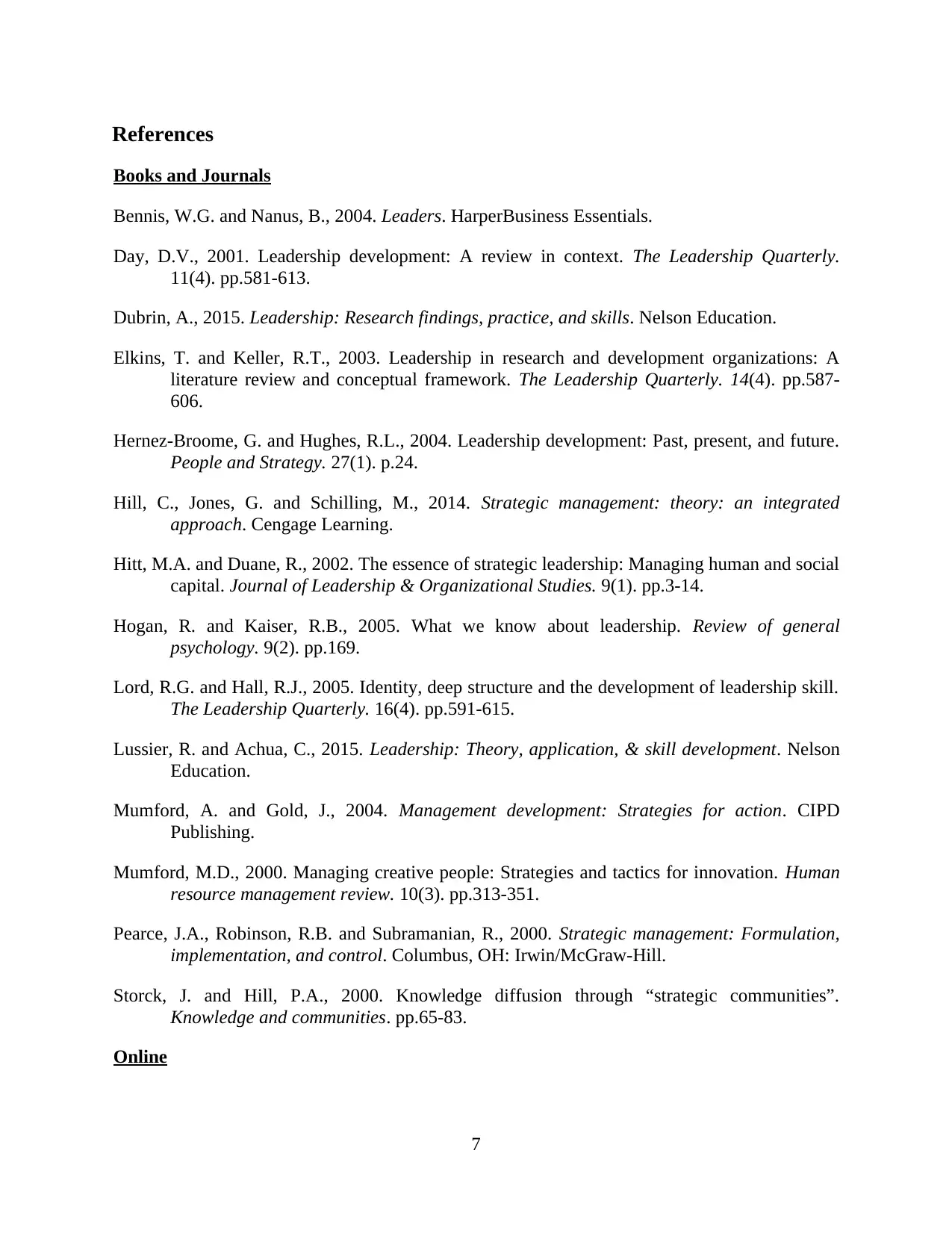
References
Books and Journals
Bennis, W.G. and Nanus, B., 2004. Leaders. HarperBusiness Essentials.
Day, D.V., 2001. Leadership development: A review in context. The Leadership Quarterly.
11(4). pp.581-613.
Dubrin, A., 2015. Leadership: Research findings, practice, and skills. Nelson Education.
Elkins, T. and Keller, R.T., 2003. Leadership in research and development organizations: A
literature review and conceptual framework. The Leadership Quarterly. 14(4). pp.587-
606.
Hernez-Broome, G. and Hughes, R.L., 2004. Leadership development: Past, present, and future.
People and Strategy. 27(1). p.24.
Hill, C., Jones, G. and Schilling, M., 2014. Strategic management: theory: an integrated
approach. Cengage Learning.
Hitt, M.A. and Duane, R., 2002. The essence of strategic leadership: Managing human and social
capital. Journal of Leadership & Organizational Studies. 9(1). pp.3-14.
Hogan, R. and Kaiser, R.B., 2005. What we know about leadership. Review of general
psychology. 9(2). pp.169.
Lord, R.G. and Hall, R.J., 2005. Identity, deep structure and the development of leadership skill.
The Leadership Quarterly. 16(4). pp.591-615.
Lussier, R. and Achua, C., 2015. Leadership: Theory, application, & skill development. Nelson
Education.
Mumford, A. and Gold, J., 2004. Management development: Strategies for action. CIPD
Publishing.
Mumford, M.D., 2000. Managing creative people: Strategies and tactics for innovation. Human
resource management review. 10(3). pp.313-351.
Pearce, J.A., Robinson, R.B. and Subramanian, R., 2000. Strategic management: Formulation,
implementation, and control. Columbus, OH: Irwin/McGraw-Hill.
Storck, J. and Hill, P.A., 2000. Knowledge diffusion through “strategic communities”.
Knowledge and communities. pp.65-83.
Online
7
Books and Journals
Bennis, W.G. and Nanus, B., 2004. Leaders. HarperBusiness Essentials.
Day, D.V., 2001. Leadership development: A review in context. The Leadership Quarterly.
11(4). pp.581-613.
Dubrin, A., 2015. Leadership: Research findings, practice, and skills. Nelson Education.
Elkins, T. and Keller, R.T., 2003. Leadership in research and development organizations: A
literature review and conceptual framework. The Leadership Quarterly. 14(4). pp.587-
606.
Hernez-Broome, G. and Hughes, R.L., 2004. Leadership development: Past, present, and future.
People and Strategy. 27(1). p.24.
Hill, C., Jones, G. and Schilling, M., 2014. Strategic management: theory: an integrated
approach. Cengage Learning.
Hitt, M.A. and Duane, R., 2002. The essence of strategic leadership: Managing human and social
capital. Journal of Leadership & Organizational Studies. 9(1). pp.3-14.
Hogan, R. and Kaiser, R.B., 2005. What we know about leadership. Review of general
psychology. 9(2). pp.169.
Lord, R.G. and Hall, R.J., 2005. Identity, deep structure and the development of leadership skill.
The Leadership Quarterly. 16(4). pp.591-615.
Lussier, R. and Achua, C., 2015. Leadership: Theory, application, & skill development. Nelson
Education.
Mumford, A. and Gold, J., 2004. Management development: Strategies for action. CIPD
Publishing.
Mumford, M.D., 2000. Managing creative people: Strategies and tactics for innovation. Human
resource management review. 10(3). pp.313-351.
Pearce, J.A., Robinson, R.B. and Subramanian, R., 2000. Strategic management: Formulation,
implementation, and control. Columbus, OH: Irwin/McGraw-Hill.
Storck, J. and Hill, P.A., 2000. Knowledge diffusion through “strategic communities”.
Knowledge and communities. pp.65-83.
Online
7
⊘ This is a preview!⊘
Do you want full access?
Subscribe today to unlock all pages.

Trusted by 1+ million students worldwide
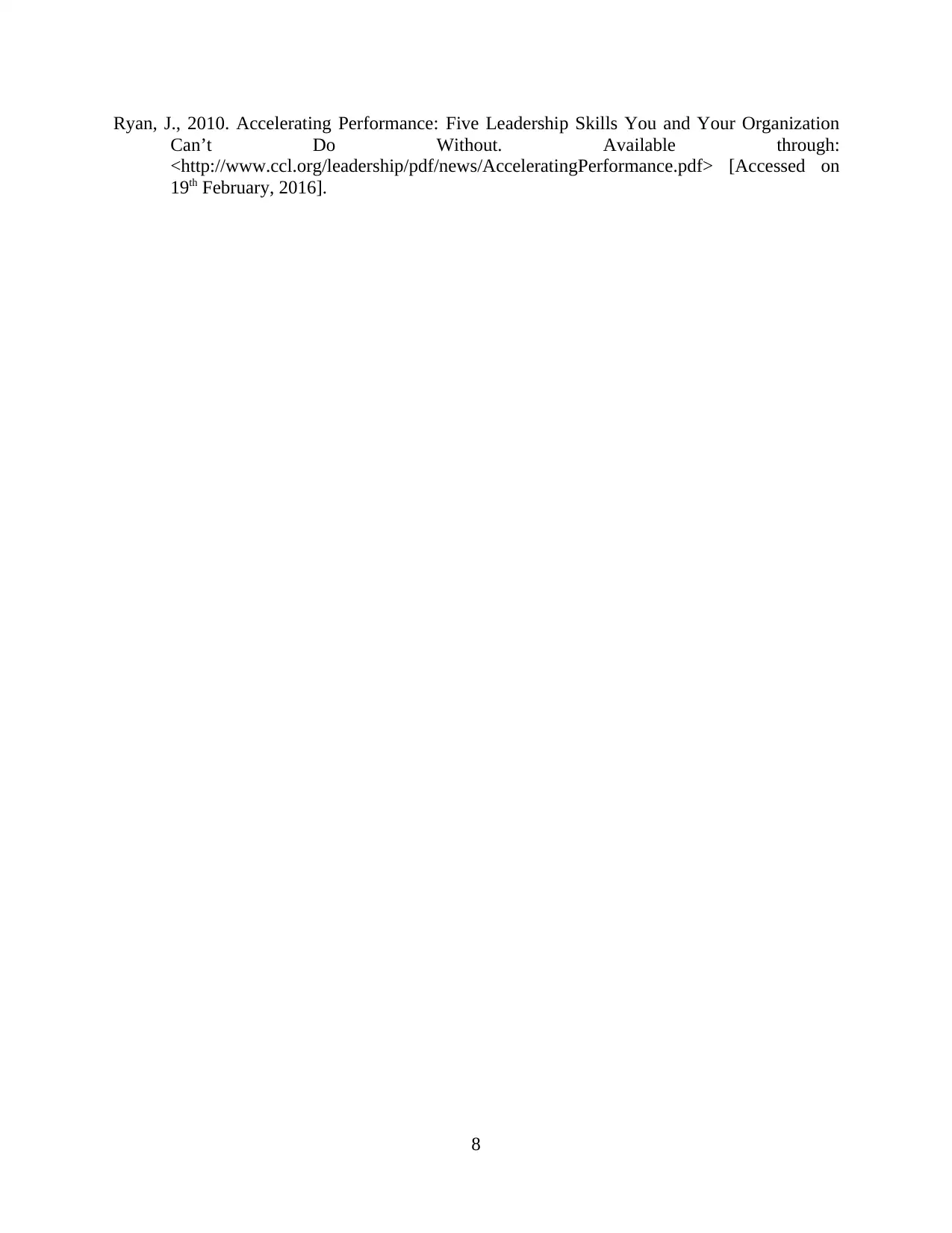
Ryan, J., 2010. Accelerating Performance: Five Leadership Skills You and Your Organization
Can’t Do Without. Available through:
<http://www.ccl.org/leadership/pdf/news/AcceleratingPerformance.pdf> [Accessed on
19th February, 2016].
8
Can’t Do Without. Available through:
<http://www.ccl.org/leadership/pdf/news/AcceleratingPerformance.pdf> [Accessed on
19th February, 2016].
8
1 out of 10
Related Documents
Your All-in-One AI-Powered Toolkit for Academic Success.
+13062052269
info@desklib.com
Available 24*7 on WhatsApp / Email
![[object Object]](/_next/static/media/star-bottom.7253800d.svg)
Unlock your academic potential
Copyright © 2020–2025 A2Z Services. All Rights Reserved. Developed and managed by ZUCOL.




